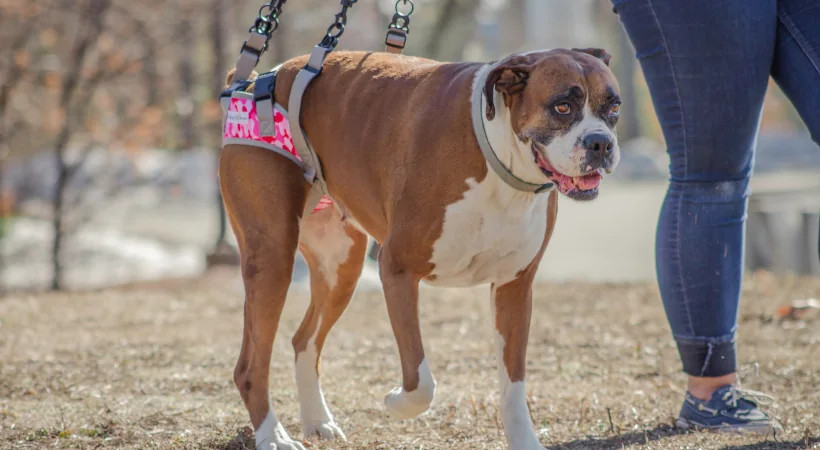
There are lots of the reason why a canine experiences hind leg weak spot. Whether or not attributable to previous age or a mobility situation, life turns into extra difficult when a canine loses energy in its again legs. Many canine with weak again legs wrestle when getting up, have issue leaping, and a few even wrestle to stroll.
As a pet dad or mum, it’s worthwhile to take note of indicators of change in your canine’s mobility, and understanding why your canine’s legs are dropping energy might help you identify the easiest way to assist your canine.
Indicators Your Canine is Dropping Energy in Their Again Legs
The indicators that your canine’s legs are weakening can begin out slowly and worsen over a protracted interval or seem seemingly in a single day. All the time take discover of any modifications in your canine’s conduct, look, or actions. The slightest change could point out a change in your canine’s well being and mobility. Indicators of again leg weak spot embody:
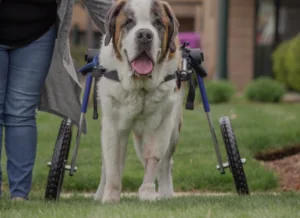
- Struggling to face up after resting
- Change in gait or pace of strolling
- Hind finish swaying
- Sudden lack of stability
- Stumbling whereas strolling
- Taking wobbly steps or instability
- Reluctance to play or go exterior for a stroll
- Incapability to leap in or out of the automotive
- Struggling to climb stairs
- Lack of muscle mass (particularly within the hind finish)
- Falling over or collapsing
At first, the signs could happen sometimes. Many canine lose energy of their again legs slowly over an prolonged time frame. The modifications of their mobility are barely noticeable at first. Many pet dad and mom could chalk up their canine’s struggles as a pure slowing down from getting older, and it might be true, however in the event you discover any indicators your canine is changing into weaker, converse to your veterinarian. There’s no purpose to attend, and early therapy could even stop leg weak spot from progressing any additional.
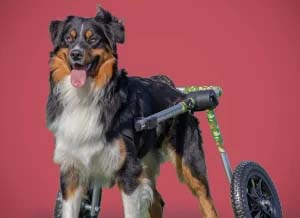
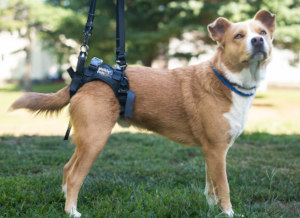
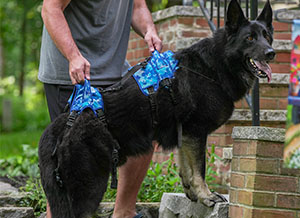
6 Widespread Causes of Hind Leg Weak spot in Canine
Hind leg weak spot in canine could be a pure a part of the growing older course of. Nonetheless, it can be the primary signal that your canine is experiencing mobility loss. The reason for your canine’s again leg weak spot may be attributable to an Inherited well being problem like hip dysplasia or degenerative myelopathy, harm, arthritis, or a neural situation.
Listed here are among the extra frequent mobility circumstances that trigger weak spot in a canine’s legs:
Outdated Age and Mobility Loss in Senior Canine
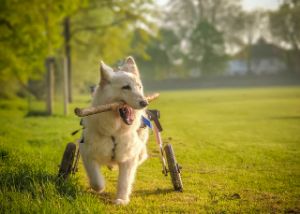
Senior canine are likely to “decelerate” as they become older, however their slowing can usually be attributed to arthritis or one other underlying well being situation. It’s fairly frequent for older canine to have hassle getting up with their again legs.
We all know that senior pets will sleep extra and transfer much less, but it surely’s necessary to not ignore the warning indicators of mobility loss. Too usually, pet dad and mom say they waited too lengthy to get their canine assist and need they’d achieved one thing sooner. Mobility loss is commonly progressive and can worsen. The farther alongside a canine’s leg weak spot has gone, the tougher it’s for it to rebuild its leg energy. To assist an previous canine with weak again legs, contact your veterinarian. Keep in mind, even the oldest of canine profit from early intervention and therapy.
Canine Muscle Atrophy
The bodily modifications in your canine’s physique attributable to muscle atrophy are straightforward to identify. As canine develop into much less lively, their muscle mass start to atrophy. Canine which might be ailing, coping with joint ache, or struggling to stroll will lose muscle mass sooner than different canine. Most canine will present indicators of atrophy of their hips and hind legs first, which can make their hind ends look shrunken. Ataxia, progressive limb weak spot, hind leg crossing, and dragging toes are frequent in canine experiencing muscle atrophy.
Leg Damage
Canine leg accidents like a cruciate tear, damaged bone, or mushy tissue harm can all impression how your canine strikes as they get better and might even trigger long-term harm relying on the character of the harm. Canine which might be laid up with a protracted restoration from a traumatic leg harm or surgical restoration could also be on prolonged crate relaxation as they heal. Being unable to stroll or transfer recurrently can weaken their again legs. Usually, this leg weak spot is barely short-term, but it surely definitely impacts a canine’s bodily and emotional well-being.
Your pet’s restoration plan will fluctuate relying on the character of the harm, however set up a plan along with your veterinarian on how (and when) your canine can get again up on its toes safely.
Hip Dysplasia or Arthritis
Aching joints from arthritis or hip dysplasia could make each step a canine takes painful. Persistent joint and hip ache can discourage a canine from their day by day actions, inflicting them to develop into torpid and reluctant to face or stroll. Canine want common train to remain wholesome, and it doesn’t take lengthy for a “down canine” to lose each leg energy and muscle mass.
Degenerative Myelopathy
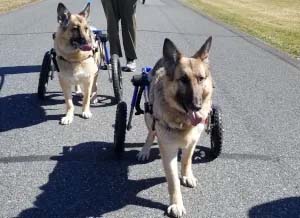
Canine identified with Degenerative Myelopathy expertise progressive mobility loss. In its earliest levels, canine with DM will expertise hind leg weak spot, dragging rear paws (also referred to as knuckling below), and might see vital muscle loss.
Degenerative Myelopathy can progress rapidly, and canine with DM will ultimately develop into paralyzed. Sooner or later, each DM canine would require a wheelchair for continued mobility and assist. One of the best canine wheelchair for Degenerative Myelopathy is an adjustable wheelchair the place the entrance wheels may be added later when wanted.
IVDD
Intervertebral Disc Illness is a standard reason for sudden mobility loss in canine. Canine with IVDD expertise a sudden disc rupture or herniation that may impede the nerves within the spinal wire. Usually, a canine experiencing a herniated disc from IVDD will yelp after which be unable to stroll. A canine’s paralysis could also be short-term or everlasting, relying on the severity of the slipped disc and how briskly they obtain therapy. Many IVDD canine would require crate relaxation, again assist, a canine wheelchair, and even surgical procedure to right their disc problem.
Find out how to Assist Your Canine When Their Again Legs Give Out
As a pet dad or mum, there may be nothing worse than watching your finest buddy wrestle to face and stroll on their very own. In case your canine can not assist itself on their hind legs or has their again legs collapse below them, they want mobility assist. Fortunately, there are easy options obtainable that can assist you assist your canine when its again legs give out. Listed here are a number of methods you’ll be able to assist assist a canine with weak again legs:
Rear Lifting Harness for Canine with Hind Leg Weak spot
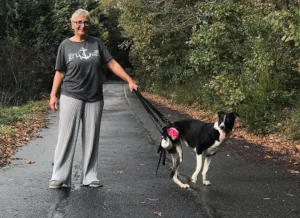
The very first thing each pet dad or mum wants to purchase for a canine with hind leg weak spot is a rear harness. Even canine who solely expertise occasional weak spot of their again legs will profit from a rear lifting harness.
A rear harness is straightforward to make use of; most are designed to slip up a canine’s again legs and fasten over its hind finish, with handles to mean you can assist your canine from beneath. For canine whose hind legs will develop into weaker or want a long-term mobility resolution, select a rear assist harness that attaches to a canine’s wheelchair for continued mobility.
Canine Wheelchairs for Weak Again Legs
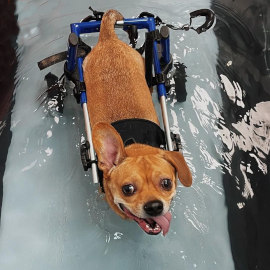
Opposite to well-liked perception, canine wheelchairs aren’t just for paralyzed canine. Canine wheelchairs assist the again legs to supply stability and make it simpler for canine to stroll, run, and play, whereas nonetheless utilizing all 4 legs.
As a canine’s again legs weaken, easy actions like having fun with a day by day stroll or going exterior to pee and poop can develop into tiring. As canine lose energy of their again legs, they could sway, stumble, wrestle to stroll, and tire rapidly. A canine wheelchair can provide your canine the assist they should keep their independence, stroll confidently, and get rid of the worry that they could immediately lose their stability or fall.
Mobility carts for canine may even be used for short-term rehabilitation in pets, rebuilding their energy whereas recovering from surgical procedure or therapeutic from an harm. For instance, canine wheelchairs relieve and scale back the strain positioned on aching leg joints to permit a canine to slowly construct up their leg energy whereas staying lively.
Constructing Leg Energy By Canine Rehabilitation
Restoration from again leg weak spot could also be doable, however this tremendously depends upon what’s inflicting the lack of leg energy. For instance, canine who’ve skilled atrophy and muscle loss attributable to harm or surgical restoration stand a great likelihood of regaining energy of their again legs.
Nonetheless, canine whose legs are weak attributable to a degenerative situation or different mobility circumstances could by no means regain full use of their again legs. However, all animals, no matter analysis, profit considerably from canine rehabilitation. Rehab remedy contains structured workouts, stretching, and therapeutic therapies that assist canine strengthen their muscle mass, construct energy, and even assist stop or not less than decelerate atrophy.
Many rehab specialists use hydrotherapy and underwater treadmills to assist canine strengthen their again legs. The water’s resistance and buoyancy assist ease the ache in aching leg joints and make it simpler for a canine to remain lively. And since most canine love water, they’ve enjoyable on the identical time!
Canine Hip Help for Pets with Dangerous Hips
Surgical procedure isn’t the one possibility for a pet coping with hip dysplasia or hip ache. Hip dysplasia may be painful and make each step excruciating. A canine hip brace relieves joint ache and helps to safe the hip joint to stop additional harm. A canine hip brace applies strain and compression over the hip joint to alleviate hip ache and creates a way of “raise” to the leg, which inspires a canine to stroll. Continued mobility is essential to a canine’s rehabilitation; combining hip assist with low-impact workouts helps to strengthen leg muscle mass and the encompassing tissue to assist canine attain a degree the place they could now not want hip assist to face or stroll on their very own.

Associated Articles:
Did we reply all of your questions on “Leg Weak spot”?
This Article is Supply Fromwww.handicappedpets.com







